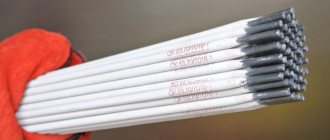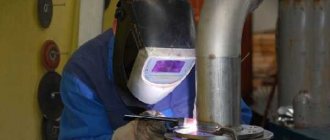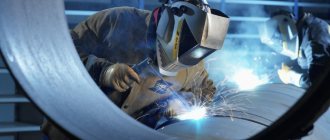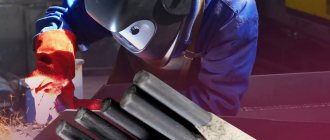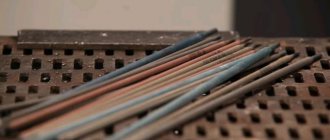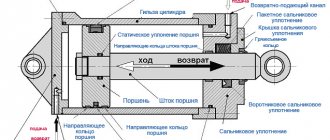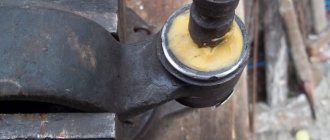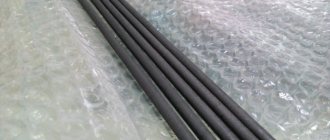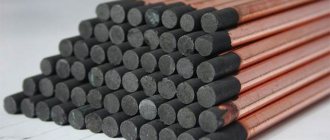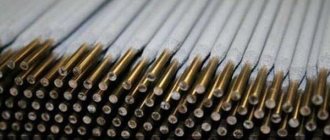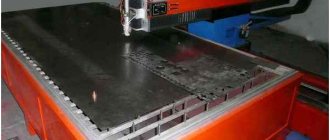Any cutting process requires the use of consumables. Plasma cutting is no exception. Timely replacement of consumables guarantees the preservation of the quality of the materials produced, eliminates defects, and also plays an important role in the long-term operation of the equipment.
It is best to purchase original consumables for plasma cutting, since the companies that produce them guarantee high productivity of the work process, excellent reliability and extended service life of the equipment.
It is the original consumables for plasma that can provide consistently high quality cuts. Such materials are produced by the company HYPERTHERM, whose products have good characteristics at an affordable price.
Types of consumables for plasma cutting
An electrode (aka cathode) is a part of a plasmatron, made of a refractory metal and having inserts made of tungsten, hafnium or zirconium. Depending on what equipment it is required for, different parts are selected.
An important role is played by the nozzle, which forms a plasma jet of the desired shape. It can be a contact element if the device does not have high-frequency ignition. It is usually made of copper or steel, and its design also depends on the type of specific machine.
Due to the nature of its function, the nozzle is considered one of the fastest wearing elements. To protect the main components of the plasma torch from dust and hot metal particles, a ceramic nozzle is used - a special protective cap made of thermoplastic.
The diffuser or swirler, as it is also called, is also a necessary element that provides an increase in pressure and expansion, that is, a slowdown in flow during operation.
A hand torch is a device that generates plasma during the cutting process. It connects to a power source and provides high-quality metal processing. The main components of the device are the electrode and its holder, nozzle, arc chamber, insulator (separating the electrode and nozzle units), as well as gas and water supply systems. It is also possible that there is a vortex node.
The guard makes it easier to move the torch and allows for smooth, consistent cuts. And for cutting without it, a deflector is used. Special casings for plasma cutting are also purchased. They operate over fairly large cutting thickness ranges and, depending on the system used, provide different operating speeds.
Causes of premature electrode wear
There are several reasons, let's look at each briefly. Also, as you read the article, we will suggest where to buy electrodes at the lowest prices in your city or region.
The air has impurities
The air supplied by the compressor must be free of oil and moisture. The filter with moisture separator must be checked every day.
Low quality plasma gas
The choice of plasma-forming gas depends on the set of consumables. It is very important to use gas strictly in accordance with the “Operation Manual”. For example, when working with inert gases (a mixture of argon with hydrogen and nitrogen), oxygen or even air should not be allowed to enter this environment. This will lead to premature combustion of the tungsten insert.
Insufficient gas pressure
The gas pressure specified in the Operating Manual should be maintained.
Low pressure and, as a result, a decrease in gas flow leads to the following consequences:
- the electrode burns out;
- sparking occurs;
- the result is a low quality cut;
- The power of the power supply drops.
Interesting: Selecting and replacing a nozzle for plasma cutting
Increased pressure sharply reduces the service life of the electrode (the power does not change).
There is not enough coolant in the plasmatron
In plasma torches, for cooling, a coolant (coolant) circulates between the anode and cathode: deionized water or a mixture of deionized water and pure ethylene glycol. Most models are equipped with a low pressure and flow fuse for this fluid. It prevents overheating of the plasma torch in the event of a malfunction of the cooling system or low coolant consumption, so it is necessary to monitor its serviceability.
If the service life of the electrode becomes shorter than usual, check the coolant flow rate.
Dirty gas pipelines
Even after short-term downtime, gas pipelines need to be cleaned. If the device is operated in conditions of high humidity, then pre-cleaning will not be enough and a complete cleaning should be carried out immediately. Moisture from the gas pipeline can settle on a poorly cleaned electrode and damage it.
The swirler is faulty
The swirler may have various malfunctions:
- burst;
- the circuit is damaged;
- melted.
Even if it is simply clogged with dirt, then in this case the amount of air consumed and even the direction of its movement changes. All this will quickly lead to failure of the electrode. Urgent replacement of the swirler is required.
If the electrodes are changed in a timely manner, the plasma torch will delight its owner for a long time.
Selection options
You need to choose the right type of consumables, taking into account their capabilities, so that they serve long and reliably. Rational use of consumables is possible if their capabilities are taken into account. So, for example, the nozzle and electrode can withstand different numbers of penetrations depending on the following three factors:
- metal type;
- sheet thickness;
- current value.
The type of metal, especially non-ferrous (or alloy), plays a very important role, as it affects the type of consumables required. Stainless or carbon steel, as well as aluminum, can be cut. And for cutting stainless steel at an angle, another separate category of consumables is used. There is also a plasma torch hose package and a whole list of spare parts for it, which include cutter kits, lubricant, couplings and more.
Schemes of a plasma cutter using the example of the APR-91 device
When considering the electrical circuit diagram, we will use the APR-91 plasma cutting machine as a donor.
Power section diagram (click to enlarge)
Plasma cutter control circuit (click to enlarge)
Oscillator circuit (click to enlarge)
How to determine the wear of consumables?
Timely replacement of consumables helps prevent defects when cutting parts, and is also an important measure to prevent problems. Worn elements of the plasma torch can cause its failure and that is why it is so important to be able to determine their condition. There are several points to pay attention to.
1. Color of the plasma arc - over time it becomes greenish.
2. Sound - a characteristic noise occurs during operation.
3. The height of the plasma torch, which decreases during burning.
Of course, in addition to the appearance of all the listed signs, there is another way. This is a determination of the edge quality of parts cut by a plasma torch. Its decline is the best criterion for determining the condition of the torch. If you see the first signs of deterioration in cut quality, then you should pay attention to the condition of the nozzle and electrode.
The easiest way to track the degree of wear of consumables is to have a special journal. With its help, you can record how long on average they work before they become unusable. As a result, it is quite possible to determine the “life” of a particular component. Thanks to such a magazine, it will be possible to plan in advance the replacement of nozzles and other consumables. This is very important, because such an approach will make it possible to avoid breaking the cutter, and the quality of the manufactured parts will always be at its best.
The nozzle should be replaced if its surface is deformed. The cause is molten metal entering due to the small height of the piercing or failure to cut through the metal. If the outlet hole begins to differ in shape or circumference, this is also a signal to replace the material.
To determine whether an electrode is worn, simply look at the silver metal insert on the end of the copper electrode. If the crater depth is less than two mm (or up to 2.2 for argon and nitrogen), then such an electrode is fully operational.
The diffuser requires replacement if cracks, clogged holes, or general wear appear. Swirlers, together with protective caps, are consumables that are generally replaced quite often, even prematurely. However, sometimes you can simply clean them with sandpaper and put them back into use.
Eckert plasma cutting machine SAPPHIRE BL2 in operation:
It is known that the cathode in plasma welding, in particular in the design of a plasma torch, is the electrode itself. So, it is the electrode that provides this function, and it is thanks to it that most of the work is done.
However, did you know that cathode electrodes, in their design and characteristics, are completely different. Thus, now we will take a more detailed look at all existing types of cathode electrodes for plasmatrons, after which you can decide which one you need.
So, in devices operating on direct current, two main groups of plasmatrons can be distinguished:
- This is a plasmatron with a rod cathode;
- and plasma torches with distributed cathodes.
For you to understand, plasma torches with a rod cathode have a cathode spot, which is fixed at the very end of the electrode. But in plasma torches with a distributed cathode, this spot moves intensively due to the influence of gas vortex or magnetic rotation along the very surface of the electrode.
To work with metals, as a rule, rod cathodes are used, which in turn are also divided into several categories, these are:
- consumable cathodes;
- gas-protected cathodes;
- film-protected cathodes.
Consumable electrodes, as a rule, include graphite electrodes, which are used very often in conjunction with a water stabilization system. The fact is that the graphite rod has a very high melting point, and at operating temperature, it does not melt, but only sublimes, which only increases its consumption.
Gas-protected electrodes include a tungsten rod. Perhaps this type is the most common. It is used when working with both inert welding and restoration welding, withstanding loads in the range of 15-20 A/mm2, while the tungsten rod is practically not consumed. In addition, it is much stronger than a graphite cathode and has better electrical conductivity.
Later than the others, a film-protective cathode appeared, which has very high protection and resistance in gases that contain oxygen (this can be carbon dioxide, air, technical nitrogen, and so on). Such a rod is actually made of zirconium and pressed into a special copper holder. Zirconium, in turn, has high heat resistance, but a relatively low melting point - only 2125 ° K, which, in turn, helps to form a stable and refractory film of oxides that protects it (zirconium) from evaporation. Today, in plasma torches that use a zirconium cathode, operating currents of up to 400 A are used. During operation and ignition of the arc, the zirconium insert goes deep into the copper cage, after which, through one of the stabilization methods (magnetic or gas), a working arc of a directed direction is formed actions. This method is technically and structurally complex, and there are often difficulties with the direction of the cathode spot and low arc stability.
Thus, the most common, easy to operate, and not too expensive, as a rule, is a plasmatron with a tungsten rod, since it contains the greatest number of positive qualities and the least number of disadvantages.
Price
Due to the strict deflection angle requirements of plasma cutting, it is necessary to increase the kerf width and replace worn parts relatively frequently. However, this applies most of all to the case when gas cooling is used. Only the nozzles and electrodes require frequent regular replacement. If the pipes are changed after five hundred to six hundred cuts, then the electrodes are changed almost twice as often.
A month of work requires a small volume of both types of consumables, which could fit in a small handbag. Since genuine plasma consumables provide better quality at an affordable price, plasma cutting is very economical.
